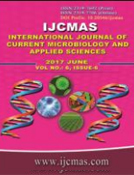


 National Academy of Agricultural Sciences (NAAS)
National Academy of Agricultural Sciences (NAAS)

|
PRINT ISSN : 2319-7692
Online ISSN : 2319-7706 Issues : 12 per year Publisher : Excellent Publishers Email : editorijcmas@gmail.com / submit@ijcmas.com Editor-in-chief: Dr.M.Prakash Index Copernicus ICV 2018: 95.39 NAAS RATING 2020: 5.38 |
A field experiment was conducted to assess the carbon sequestration potential of native vegetation in trees, shrubs and herbs at Nattarasankottai Village, Sivaganga district in Tamil Nadu that lies between N 9°52’13.37’’ and E 78°33’06.80’’. The native vegetation was assessed for its carbon accumulation potential in five trees, nine shrubs and six herbs. Among the five tree species, Acacia leucophloea exhibited maximum biomass carbon content of 532.32 kg ha-1 and minimum in Acacia mellifera (77.99 kg ha-1). Whereas in shrub species, Dodonaea viscosa recorded the highest biomass carbon content of 1391.42 kg ha-1 and lowest in Opuntia dellenii (29.36 kg ha-1). In herbs, Sida cordifolia exhibited highest biomass carbon content (262.09 kg ha-1) and the lowest in Ocimum basilicum (41.24 kg ha-1). The field study inferred that, Acacia leucophloea (Trees), Dodonaea viscosa (Shrubs) and Sida cordifolia (Herbs) contributed maximum biomass carbon content to the native vegetation under dry land condition.
 |
 |
 |
 |
 |